Menus
- Single cylinder, 4-stroke, 124 cc, 15 hp, 133 kilos, from € 4,099
- A stylish and sporty little roadster for young people or beginners
- Discovery
- In the saddle
- Engine and transmission
- In the city
- On motorways and main roads
- On departmental
- Part-cycle
- Brakes
- Comfort and duo
- Consumption / autonomy
- Conclusion
Single cylinder, 4-stroke, 124 cc, 15 hp, 133 kilos, from € 4,099
A stylish and sporty little roadster for young people or beginners
The roadsters being fashionable and selling like hot cakes, we understand the approach of the manufacturers which consists in offering the youngest possible target this type of machine, to then try to retain them.. This is clever. Thus, on a niche where we already find the Aprilia Tuono 125, the KTM Duke 125 and the Yamaha MT-125, Suzuki arrives on the market with a pair of seductive 125: the sporty GSX-R 125, which the we just tried and this GSX-S 125 roadster, with which she shares a large number of elements.
This allows Suzuki to complete the line of GSX-S downwards: after the 1000 and the 750, here is the 125. Well, there is no lack of a 400 in the range, for A2 licenses? A small old-fashioned 4-cylinder that grinds at 16,000 rev / min, that would have trouble. But let’s stop dreaming and let’s take a look at this machine that must make a bunch of teenagers dream that they would like to go with it on their way to high school..
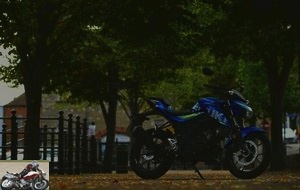
Discovery
Thin, slender, sporty: the GSX-S 125, like its big sisters, announces the color. The 125s are rarely big turkeys, but this GSX-S, like the GSX-R we tested the day before, is really tiny. Large sausages will be cramped (a good reason to start a diet), small builds and frail teens will say thank you. The advantage is that it is easy to handle; we will come back to that. It is also light, even very light, since at 133 kilos Suzuki claims it is the lightest in the category..
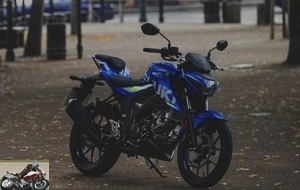
There is no doubt that this machine has sporting pretensions: the bottom of the saddle is typed "racing", the "MotoGP" replica colors (which are then worth an additional 100 euros) will speak to Grand Prix fans. The front takes the optics of the GSX-R, extended by a cover that goes to the small digital dashboard. In the absence of full fairing, the side scoops hide the water radiator well and the voluminous exhaust silencer and its double outlet, provide additional credibility. !
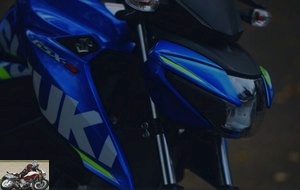
In the saddle
Two major differences are to be noted compared to the GSX-R and which impact the pilot as soon as he climbs into the saddle: the keyless switch has disappeared, it is a premium equipment which justifies the additional price of the sports car. Thus, Suzuki has instead implemented the ignition key hole blocking system, which is also found on its scooters. In the absence of a coded key, this avoids forcing the steering or starting with a screwdriver.
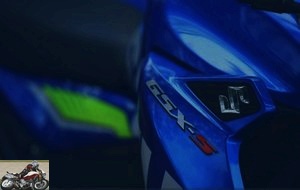
Second difference: the handlebars are 10 cm higher and this therefore significantly changes the riding position, while this does not change at the level of the saddle and the footrests. The dashboard is the same as on the GSX-R: it is therefore complete, with a fuel gauge, a gear indicator engaged, a shift-light and even an average consumption indicator. And before leaving, we appreciate the Easy Start function, which starts the engine with a single press on the starter..
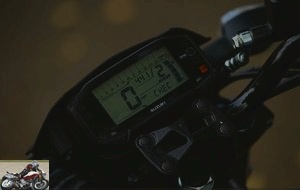
Engine and transmission
Identical, again, to that of the GSX-R. We see that it has a short stroke (62 x 41.2 mm), it is quite simply because this engine comes from the 150 cm3 versions sold in Asia and that with a shorter connecting rod we make a 125 again. This is a new engine in the Suzuki range, which stands out for its elasticity: torque at 8,000 rpm, power at 10,000 rpm, red zone at 11,500 rpm and extension up to 12,000 rpm. This is because the GSX-S has sporting pretensions. A 6 box completes the case. Finally, despite a large air box (4.3 liters) and a large tank (11 liters), the machine remains fine !
In the city
Unlike the GSX-R 125 tested exclusively on the track, we were able to drive around town with this GSX-S: and it is doing absolutely well. Not only is the more upright driving position more natural, but the steering angle has also increased from 35 ° to 40 °. Result: the GSX-S literally plays with urban congestion, well helped in addition by its compactness and narrowness. Another good news: we had the feeling the day before on the track with the GSX-R, but the use in real life and in the real city confirms it. The engine is voluntary and already resumes in an honorable way from 5000 or 6000 rpm, which makes it possible not to remain stuck between two cars which would want to harm you. Finally, the softness of the controls (gas, clutch, gearbox, brakes) will make everyday life very pleasant. !
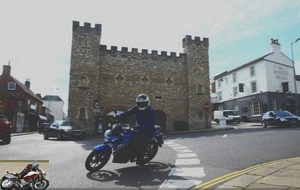
On motorways and main roads
But it’s because she walks this little motorcycle! Like what, 15 real horses and a contained weight, that helps! In fact, it is not difficult to exceed the 130 km / h "counter", full sixth and lowering the head a little. Could the GSX-S 125 get flashed on the highway? Faced with a radar placed in a very very dangerous place (at the bottom of a deserted descent, for example), it is almost probable !
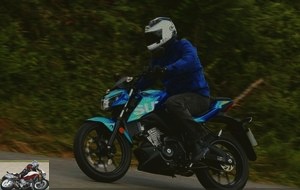
Obviously, out of respect for the mechanics, we do not remain permanently welded (except to be a dirty nag, which is also your right, dear reader). Suddenly, on a small, say medium stream of gas, it holds the 110 cruising at 9000 rpm in sixth, without flinching. Considering the speeds, to speak of problematic stability would be a bit of an abuse !
On departmental
With this voluntary engine, which picks up well and offers a range of use from 7/8 to over 11,000 rpm, we get caught up in the game and drive without dragging ourselves. On a winding route, the GSX-S 125 will give a lot of pleasure to its young driver. Hyper agile, it throws itself at the cord of turns without any inertia and its relatively rigid frame allows to be precise in the trajectories..

Thus, the GSX-S, at its scale of course, has that feeling of a sporty roadster specific to the line of the larger-displacement GSX-S. However, there are a few limitations discussed below..
Part-cycle
Of course, it is possible to have fun riding this bike. Of course, you can go fast with it, as we did with its sister the GSX-R 125 on the circuit and also on the road with this model. Because the test was a bit of the kind: be careful, we let out a pack of journalists, they will go full speed everywhere. Except in the villages, they are not savages either. In short, it does and a young biker will have a lot of sensations !
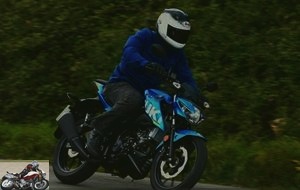
However, Suzuki places its GSX-S 125 a little more modestly on the market: its competitors are worth 400 (KTM), 500 (Aprilia) or even downright 900 euros more, at Yamaha, which does not blow its foot! Except that there is one detail: all its competitors sport inverted forks and beefier swingarms, even an aluminum perimeter frame and real tires! In fact, despite its racy look, the Suzuki ultimately has a fairly basic chassis, with a classic, low-section fork, as well as a traditional steel swingarm. The tires are Dunlop D102, with a fairly nonexistent feeling and grip that quickly failed on the track. Afterwards, to learn to ride a motorcycle and go to high school, it will do well at the beginning…
Brakes
Two discs, 290 mm in front (2 piston caliper) and 187 mm behind (1 piston caliper). Without being monsters of power and bite, they brake well and are consistent with the definition of the chassis. Their power is easily dosable and the ABS does not trigger inadvertently: these are two essential qualities given the intended target..
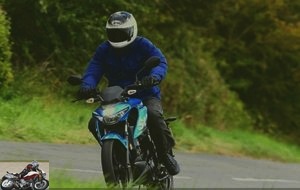
Comfort and duo
Good suspension compromise: it’s relatively firm, that’s good for the "sporty roadster" feeling, but it’s not brittle either and it works cleanly, despite the simplicity of the elements. It must be said that the contained weight plays its role here. The riding position is relaxed, the saddle seemed correct during the test. In short, for a kid, it will do well. The duo, on the other hand, will be more sporty…

Consumption / autonomy
Suzuki claims a consumption of 2.3 l / 100. During our test, carried out almost all the time at donf ", we made 4 l / 100, which can be considered as an absolute maximum. With 11 liters in the tank, the autonomy will therefore oscillate at least between 3 and 400 km, which is not bad at all. The fuel gauge is obviously a plus.
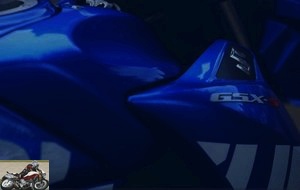
Conclusion
Stylish, modern with its fully digital dashboard and LED headlight, this little 125 plays the lineage with the lineage of the big GSX-S and it is quite right. Quite alluring in its MotoGP replica livery, it will make many teens fantasize about leaving high school … or even invigorate a forty-something who wants a simple and efficient machine to go to work. In addition, it has the good taste to be significantly less expensive than its direct competitors: a price difference that is not a miracle, because the GSX-S factually has a less elaborate chassis than the others. A tare? No ! Because in the context of daily use and commuting, there is something to have fun, especially by its lightness, its agility and especially by its truly voluntary and powerful engine, which plays an important role in this successful package. Afterwards, when we push it to the limit, well they will arrive a little faster than the others, but it will be more sensitive on the track … And not everyone does..
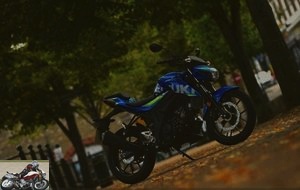
Strong points
- Efficient and voluntary engine
- Agility
- Compactness
- Complete dashboard
Weak points
- Medium attack tires
- Basic chassis and suspensions
- A narrow hair for adults
Suzuki GSX-S 125 technical sheet
Test conditions
- Itinerary: a hundred kilometers in the English countryside around Silverstone
- Motorcycle mileage: 800 km
- Problem encountered: none, we drove full speed almost all the time, it was cool
Competition: Aprilia Tuono 125, KTM Duke 125, Yamaha MT-125
Related articles
-
197 hp at 9,500 rpm, 155 Nm at 7,200 rpm, 3 engine maps, 300 km / h, € 15,499 Cut for speed, does the myth stand up to the ravages of time? ? Thursday 11…
-
The mid-size trail passes Euro 4 standards: 645 cm3, 71 hp and 62 Nm, 216 kilos, € 8,899 A simple, accessible, versatile and efficient motorcycle For 7…
-
Single cylinder, 4-stroke, 124.4 cm3, 15 hp at 10,000 rpm, 11.5 Nm at 8,000 rpm, 134 kilos, € 4,599 A little sportswoman who worthily represents the…
-
In-line twin, 248 cm3, 25 hp at 8000 rpm, 23.4 Nm at 6500 rpm, 188 kilos, € 5,749 A small road trail in the tradition of the V-Strom family Fifteen….
-
4 cylinders in line, 749 cm3, 114 hp, 8.1 m / kg, 213 kilos, from € 8,899 Suzuki’s New Midsize Roadster Offensive Is Equipped With Traction Control All…
-
The big Suzuki trail passes Euro 4: 101 hp, 101 Nm, € 13,299 ABS corner and cosmetic developments for this truly versatile machine We can live a world of…
-
The handyman The Suzuki GS 500 is the queen of motorcycle schools: a twin-cylinder of 500 puncture-proof cc at a minimum price, launched in 1989, and…
-
Suzuki GSX-R 750 motorcycle test
Out of category champion A true modern icon of motorcycling sport, the 750 GSXR pursues its solo career, without however ever visiting the paddocks or…
-
Japanese legend, successor to the GSX1100S Katana 4 cylinders in line, 999 cm3, 150 hp, 108 Nm, 215 kg full made, 13,699 euros The Katana is a very old…
-
Quiet strength 4 cylinders in line of 749 cm3, 95 hp (flanged to 47.5 hp), 62.9 Nm, 213 kg full made, 8,599 euros Born GSR in 2011, the Suzuki midsize…